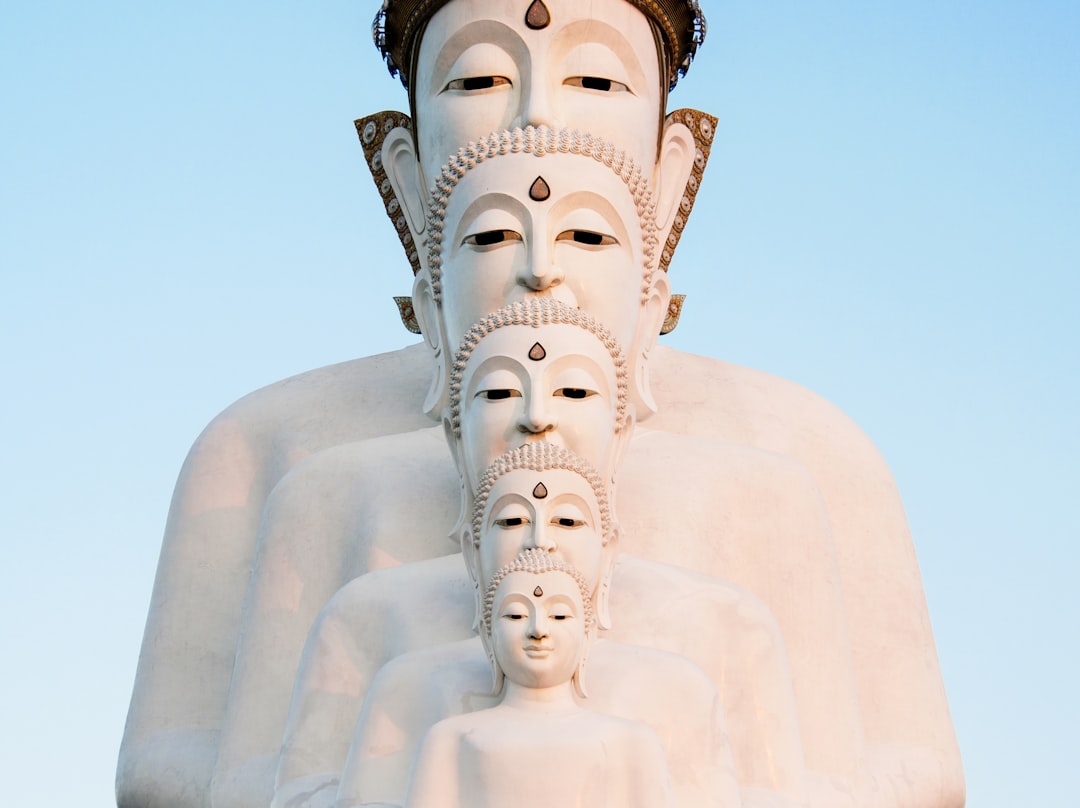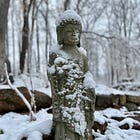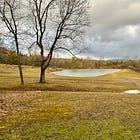O-An Zendo held its Vesak Sesshin this past weekend. Vesak is a spring holiday during which we gather to practice and celebrate the birth of Shakyamuni Buddha.
I offered the Dharma Talk on Saturday, April 6th. You can listen to a recording of the Dharma Talk from last Saturday or read a lightly edited transcript of the talk. Enjoy.
We have gathered this weekend to practice on the occasion of Shakyamuni Buddha’s birth. Technically, Siddhartha Gautama was born closer to or within our month of May. That, anyway, is what the best historical evidence suggests. Other considerations led to our holding the sesshin this weekend, notably Shuso Hossen (Dharma Inquiry Ceremony) for this year’s Shuso. Shuso Hossen will be the ceremonial conclusion to our sesshin and this year’s winter Ango (Intensive Practice Period).
That is just fine—it is excellent, even. Sometimes, it is important not to be so precise about things.
My talk today is entitled “The Promise Of You.” The title could have been “Firewood and Ash,” “Life and Death,” or “Birth and Death” because what I want to explore for the next half hour is a passage from Dōgen Zenji’s Genjōkōan that mentions all three pairs. I also want to offer something more inspirational than “Death” and “Ash,” especially since we are out of winter and into spring. And I will do that, too.
The term genjōkōan, by the way, is commonly translated as “Actualizing the Fundamental Point.” During Ango, I found another translation—a little “looser,” I read—in the writings of Taigen Dan Leighton, Roshi. He writes:
The word genjō means ‘to fully or completely manifest,’ or more loosely ‘to express or share.’ And in this context kōan does not refer to these teaching stories but to the heart of the matter. So our practice in our sitting or when we get up from our formal sitting is to fully manifest, express, or share what is essential in the situation in front of us, and to do this within ourselves, together in sangha, and for our world as a whole. Expressing what is most essential is a very rich teaching.
From a particular point of view, the whole of practice-life has as its orientation genjōkōan, “expressing what is most essential.” I encourage you to express what is most essential for the remainder of the sesshin. Whether standing, sitting, walking, or lying down, when chanting, raising the Buddha bowl during Oryoki, or folding your napkin, please express what is most essential. In a sense, it is not difficult to do: just be yourself as you are in that instant.
Here is the passage that I want us to explore together:
Firewood becomes ash. Ash cannot become firewood again. However, we should not view ash as after and firewood as before. We should know that firewood dwells in the dharma position of firewood and has its own before and after. Although before and after exist, past and future are cut off. Ash stays in the position of ash, with its own before and after. As firewood never becomes firewood again after it has burned to ash, there is no return to living after a person dies. However, in Buddha Dharma it is an unchanged tradition not to say that life becomes death. Therefore we call it no-arising. It is the established way of buddhas’ turning the Dharma wheel not to say that death becomes life. Therefore, we call it no-perishing. Life is a position in time; death is also a position in time. This is like winter and spring. We don’t think that winter becomes spring, and we don’t say that spring becomes summer.
Dōgen’s words and their meaning are absolutely clear. Right? So that we are all clear, I am joking.
I assume that all of us have seen firewood burn, thereby becoming ash. You may have witnessed this over many hours during a family gathering. A handful of logs set alight in the fireplace, and as conversations ebbed and sunlight faded from the scene, the firewood disappeared, too. Ash slowly, steadily appeared on the fireplace’s floor.
If this is not a scene from your life, recall this morning’s service. As I approached the altar at the end of Jundo, Daigen handed me a lit stick of incense, which I then offered at the altar. When just lit, the incense stick is nine or ten inches long. Yet it, too, becomes ash as service proceeds and zazen follows.
Firewood and incense sticks become ash, and ash cannot become sticks of incense or firewood again. We can view the ash as after and the firewood or stick of incense as before, but Dōgen cautions against this. “We should not view ash as after and firewood as before,” he writes.
At this point, two questions are alive. The first question is, Why? It seems evident to me that the ash is after, and the firewood or stick of incense is before. We might understand this Why? as asking for the reasons behind Dōgen’s words of caution.
The other question we can ask only after discerning Dōgen’s reasons—or what might be Dōgen’s reasons—is, How is this teaching applicable to my life? It is okay, honestly, if the teaching is only an interesting philosophical puzzle, a shiny object to gaze at with the mind’s eye. There is a place for philosophical puzzles and shiny objects. I expect, however, that there is something important that Dōgen wants to share with us, something integral to practice-life. The Genjōkōan, after all, is Dōgen’s presentation of Zen practice to a layperson.
One response to the first question focuses on the words “dharma position.” But I am not interested in that response. I do not want to talk about the words “dharma position.” Another response centers on the sentence, “Although before and after exist, past and future are cut off.”
Although before and after exist, past and future are cut off.
Let us begin here.
Recently, I spent some time thinking about hope. Some of you may recall our extended discussion one Sunday during Ango about hope, its place in Zen practice, and its relation to confidence, trust, and faith.
When we hope for something, we desire one of two things. We desire that either what was the case continues to be the case or what was the case continues not to be the case. We want either more of the same or its opposite.
If up to this point, the sesshin has been pleasant for you and you want that to continue, then you are hoping for the future to be a certain way, the same as the past. If up to this point, however, the sesshin has been unpleasant for you and you want that to change, then you are hoping for the future to be a certain way, namely, different from the past and probably the opposite of the past. You hope that your unpleasant experience in the past will become a pleasant experience in the future. Again, we want either more of the same or its opposite.
As I sat with this interpretation of hope, I wondered, Where is this past that I judge as pleasant or unpleasant? Where is this future that I hope will be pleasant in either case?
Nowhere. Or, as Dōgen puts it, both are “cut off.” What has not been “cut off”? Now. Right now. This now.
What is this now? It is a Dharma Talk and dwells in its specific position with its own before and after. Soon, there will be kin hin (walking meditation), which also dwells in a specific position with its own before and after. But we should not view kin hin as after and the Dharma Talk as before. And it may be easier to grasp why when the example involves not firewood or an incense stick and ash, but a Dharma Talk and kin hin.
I want to ask a question and encourage you to consider it: How can a Dharma Talk become kin hin?
How can a Dharma Talk become kin hin?
If you are sitting there and thinking, “Um, it … cannot?”—Good. Very good. I am not asking you a trick question, trying to appear clever.
A Dharma Talk cannot become kin hin. Where there is a Dharma Talk, there is a Dharma Talk and a before and after from the position of the Dharma Talk. When there is kin hin, there is kin hin and there is a before and after from the position of kin hin. But the Dharma Talk does not become kin hin, and kin hin cannot become the Dharma Talk. The two things are distinct, and it is easy to see that there is no causal connection between them because of the kinds of things they are.
It is less easy to see this with firewood or incense sticks and ash precisely because of the kinds of things they are and how close the disappearance of one is—in both space and time—to the appearance of the other. You can watch the flames work away at the firewood, transforming it almost instantaneously, right before your eyes, to ash. Thus, we commonly say, “Firewood becomes ash; the ash was after, and the firewood was before.” Yet to say this presupposes that something endures from one to the other. There is something, at one time appearing as firewood, that becomes something else, at a later time appearing as ash. To use a bit of philosophical jargon, there is something that subsists and persists through the change from firewood to ash and offers us solid ground on which we can stand and say, “The ash was after, and the firewood was before.”
For Dōgen, however, nothing subsists and persists through the change of firewood to ash. There is just the firewood in its position at one time; there is just the ash in its position at another time.
Since a certain amount of abstraction may prove helpful here, let me state Dōgen’s aim as I understand it and as plainly as possible: Dōgen is disrupting our ordinary understanding of the causal relation between discreet events in time. We tend to believe that there are these clean, direct, or simple causal chains that explain the connection and transformation of one event or state of affairs and another event or state of affairs. Our ordinary understanding is not much different from hundreds or thousands of dominos arranged orderly so that as the immediately prior domino knocks one over, the just-knocked domino will, in turn, knock the next one, and the next one, and so on ad infinitium.
This is not how things are, says Dōgen. The connection, transformation, and causal relation between one event or state of affairs and another is significantly more tenuous. And it is only when Dōgen has loosened our attachment to the “domino way of thinking” that the tenuousness of relations is made explicit. In fact, he severs the relation.
However, in Buddha Dharma it is an unchanged tradition not to say that life becomes death. Therefore we call it no-arising. It is the established way of buddhas’ turning the Dharma wheel not to say that death becomes life. Therefore, we call it no-perishing. Life is a position in time; death is also a position in time. This is like winter and spring. We don’t think that winter becomes spring, and we don’t say that spring becomes summer.
In the same way, we do not think that a Dharma Talk becomes kin hin. But we do suppose that firewood and incense sticks become ash. And Dōgen says, “Not so fast …” Whether it is a Dharma Talk and kin hin, winter and spring, birth and death, or firewood and ash, it is all the same. The one does not become the other, and the other cannot become the one.

So much for the first question, the Why? question. What about the second question? The How is this applicable to my life? question.
As I said at the outset, we are gathered this weekend to practice on the occasion of Shakyamuni Buddha’s birth, and I feel a need to connect my talk to that event.
What can I say about it, though? In some texts, we are told that Siddhartha was born from his mother’s side, that after being born, he took several steps in different directions, and with each step, a lotus flower bloomed underneath his feet, and he proclaimed grand words. What am I supposed to say about this?
Whatever we want to say about this fantastic series of events, Siddhartha was also a baby when he was born. Some of us delight in babies’ cuteness, small features, soft skin, giggles, and laughter—the list sometimes seems endless. And all of us, I suggest, see and smile towards something not visible yet undeniably present with every new life: promise. With every new life, we deeply feel its promise, the entirely open, unhindered, unstained, plain potential for greatness and excellence. The whole of this young being’s life is ahead of it, and, in this very instant, nothing whatsoever seems to obstruct the path. It was there for Siddhartha, certainly. It was there for us, too, even if no flowers bloomed when we took our first steps.
As we age, we feel that promise diminish. We start to see the paths of our lives narrow because of our choices and others’ choices. We become aware of cultural, societal, and other systemic influences and pressures on us, our families, and our communities. We feel the hindrances of despair and doubt; stains appear with every perceived misdeed or prolonged period of grave misconduct. We lament that we did not “live up to our potential” and that we had such promise and wasted it.
I am familiar with all of these feelings. Perhaps you are, too. I am confident that you are.
And what I want to tell you, with complete certainty, is that you never lost that promise. Not one bit. It is alive and well and no different from when you first learned to crawl.
Taizan Maezumi, Roshi, often said, “In a twenty-four-hour period alone we are being born and dying 6,500,000,000 times. It is so fast we cannot notice it.”
He is not wrong.
If we could notice it with greater ease, we would see that each birth and death, happening constantly, instantaneously and spontaneously, is no different than a Dharma Talk and kin hin, winter and spring, or spring and summer. But it is not easy to see that we are continually being born. So, we see our life just as we see firewood and incense sticks and ash. We believe that there is us, as we are now, at the sesshin, and that is after and that the baby we once were is before. We believe the past is still alive, dragging us down and constraining our future.
Although before and after exist, past and future are cut off.
You, just as you are, right here, right now, have just as much promise as you did when newly born and just as much as young Siddhartha. The Promise Of You was never lost. It was never wasted.
May you see this in yourself through diligent practice, as I see it in all of you.
Thank you very much.
If you enjoyed this offering, you might enjoy these others offerings:
The quotations from Dogen Zenji are from “Revealing Genjokoan,” by Shōhaku Okumura.
The quotation of Taizan Maezumi, Roshi, is from “Appreciate Your Life.”







three bows
Thank you for the reminder that the promise is not and cannot be lost, Taishin Michael. 🙏